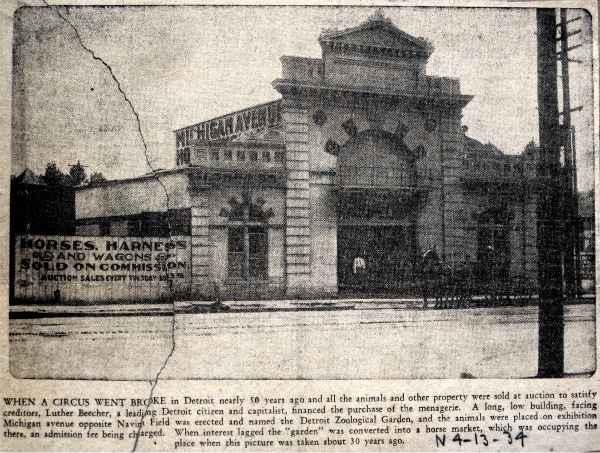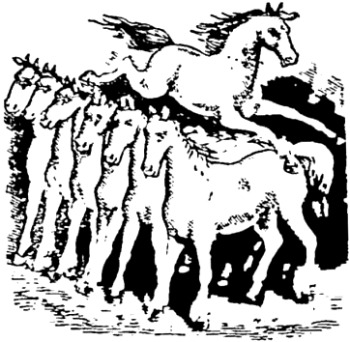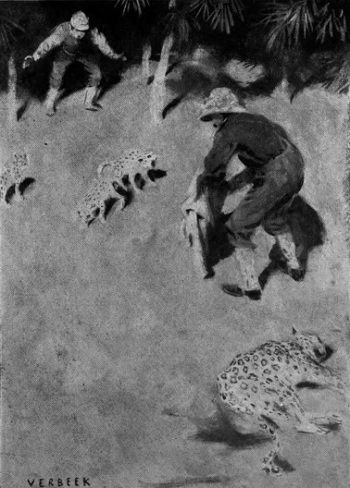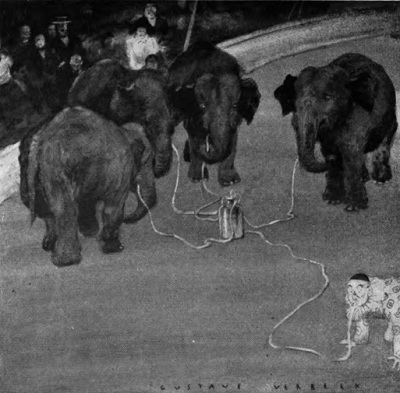The story is often told of the circus that went bankrupt, whose collection of animals became the first Detroit Zoo. The earliest reference I've found to the legend appeared in The Detroit News on April 13, 1934. A photo montage entitled "Photographic Reminders of the Good Old Days" included a circa-1906 photo of the original zoo in Corktown. The caption below it references the circus story.

Courtesy of the Burton Historical Collection, Detroit Public Library.
Photograph is courtesy of The Detroit News Archives. Used with permission.
The legend is embellished even further in The First Fifty Years: An informal history of the Detroit Zoological Park and the Detroit Zoological Society, by the zoo's Curator of Education, William A. Austin, in 1974:
The first zoological park in Detroit was established in the early 1880's, and was the result of a small traveling circus going bankrupt. The owners of the circus slipped out of town in the middle of the night and simply abandoned their animals. The citizens of the City of Detroit took up a collection to assist in housing and feeding these creatures, and the area was opened to the public on September 5, 1883.This version of events is repeated in Wonders Among Us: Celebrating 75 Years of the Detroit Zoo by the Detroit Zoological Society, and referenced on the zoo's website and in a documentary on its history.
But what really happened? The following is an attempt to reconstruct the events as they were reported at the time by the Detroit Free Press and The Detroit Evening News.
"W. C. Coup's New United Monster Shows"
This advertisement for the doomed circus ran in the Free Press in the days leading up to its Detroit opening on August 23rd, 1882.

The circus was owned by William Cameron Coup, one of the co-founders of the Barnum & Bailey Circus. He and another circus owner convinced P.T. Barnum to turn his museum into a traveling show in 1871, but the men parted ways in 1876. Coup was the first showman to use circus trains and circuses with more than one ring.
Coup's 1882 season had been going poorly, including a "premature and financially disastrous" tour of Texas (N 8/24/1882). Then disaster struck in the early morning hours of August 20, 1882. Coup's circus train was traveling in two sections from a show in Cairo, Illinois to his next engagement when the first train stalled on the tracks and was subsequently truck by the second one. Five drivers were killed, and about twenty other workers (but no performers) were injured. The circus arrived so late for the next three shows (Delphi, Indiana; Columbia City, Indiana; and Detroit) that there was no time to publicize the show with the customary circus parade. (F 1/11/1884, 3)
Despite the setbacks, Coup put on two shows in Detroit on August 23 as promised. The tents were set up in an undeveloped field in Corktown on the south side of Michigan Avenue just west of Tenth Street. Eleventh Street did not run through the property until 1890. The land, owned by Luther Beecher, was where the Zoological Garden would later be built.

(Source)
William C. Coup's New United Monster Show was no "small traveling circus" as described by Austin. In addition to the 175 performers and a full menagerie of animals--including an aquarium!--there was a "Grand Historical Tableaux" of 500 plaster statues which recreated the assassination of President James A. Garfield and the conviction of his murderer, Charles J. Guiteau. The statues of Guiteau were dressed in the very clothes he wore on the days of the assassination and his conviction.

A poster was for W. C. Coup's 1879 season by the Stobridge Lithograph Company.
Courtesy of the John and Mable Ringling Museum of Art.
Coup was so heavily in debt by the time he arrived in Detroit that he was unable to pay many of his performers. On the day of the first show, the circus' equestrian star Frank Melville, filed a praecipe for writ of attachment in Wayne County Circuit Court, which was granted (F 8/24/1882, 6). He was quickly followed by a half dozen other employees, including George Loyal, "The Human Cannon Ball".

From left to right: Frank Melville, George Loyal, and Ella Zuila.
Zuila, Loyal's wife, performed a highwire act in Coup's circus.
In addition to employees, Coup owed tens of thousands of dollars to printers, lithographers, and bill posters. Several local businessmen also won judgments, including George W. Latimer, an undertaker. Rather than attempting to fight his creditors in court, Coup decided to give up and allow the Wayne County Sheriff, Conrad J. Clippert, to seize his property in order to satisfy his debtors (F 8/25/1882, 6). Coup's circus was to be auctioned off to satisfy his creditors on September 16th.
In the meantime, the Wayne County Sheriff's Department was in charge of securing the property and caring for the animals. The approximately ninety unemployed men who were now stranded in Detroit posed another problem all together. The sympathetic Sheriff Clippert personally bought the men breakfast on the morning of the 26th. "Many of them say that they would be satisfied without any money," reported the News, "if they could secure transportation to their homes" (N 8/26/1882). The following day, Clippert allowed admission to be charged for a public viewing of the animals, with the proceeds going to benefit the stranded men (F 8/27/1882, 6).

Clippert, a German immigrant, served as
Wayne County Sheriff from 1880 to 1884.
Image courtesy of Google Books (Source)
Clippert temporarily hired fourteen of Coup's men to handle the increasingly expensive task of looking after the animals. The owner of the circus grounds, Luther Beecher (aka "Uncle Luther") first demanded $75 per day to continue using the land, which the Sheriff refused to pay (N 8/26/1882). This was later negotiated down to $25 a day (F 8/31/1882, 1). The water commissioner charged the camp $4 per day for water usage--negotiated down from $10. Simply feeding the animals was a monumental task, as the Free Press reported:
The hippopotamus and other animals with the Coup circus now stored on Michigan avenue, dispose of half a ton of hay, five or six bushels of oats, seventy-five pounds of fresh meats, eight or ten cabbages, a peck of turnips and half a bushel of apples per day. The cabbages, turnips and apples are made into a hash for the hippopotamus. (F 9/6/1882, 1)The expenses were not paid for by "the citizens of the City of Detroit [taking] up a collection" as Austin claimed, but were simply covered by the proceeds of the sheriff's auction (F 9/6/1882, 1). And neither did William C. Coup "slip out of town in the middle of the night". Coup did have to travel to New York on September 4th, but he returned eight days later. The Free Press noted that "Mr. Coup has only increased the number of friends he has here by the manly, dignified manner in which he has faced his disaster in Detroit, and there is not one who will not rejoice to see him again on his feet." (F 8/27/1882, 13)

William Cameron Coup (1837-1895)
Image courtesy of CircusHistory.org (Source)
The Auction
The first day of the auction was Saturday, September 16, 1882 at the Corktown circus grounds. News of the auction attracted representatives of circuses and zoos from as far away as Canada and Mexico. In addition to a menagerie of animals, the items for sale included the circus' canvas tents, animal cages, a steam organ, various wagons and buggies, audience seating, a catapult, blacksmith tools, band uniforms, seven railroad cars, and many items for horses, including saddles, harnesses, and bridles. Also to be sold was a "balloon", which might have been Charles F. Ritchel's "Flying Machine" seen in previous advertisements for Coup's show.

Courtesy of the John and Mable Ringling Museum of Art.
The auction began at noon and was presided by John S. Griffin, a professional auctioneer and former Wayne County Coroner. The very first item up for bid was Coup's hippopotamus, who was sold for $2,900 to William Washington Cole, founder of what is now the Cole Bros. Circus (F 9/17/1882, 8). The other purchases of animals made that day as reported by the papers were:
- William W. Cole: one wildebeest, $625; three hyenas, $33; and one yak, $150.
- Frank Thompson of the Cincinnati Zoo: two porcupines, $50; two wolves, $12; six monkeys, $84; two sun bears, sold for $200 according to the Free Press, but $220 as reported by the News; and one jaguar (Free Press: $35, News: $135).
- Harry L. Piper of the Toronto Zoo: one peccary, $11; one "ring tail" (Capuchin) monkey, $15; one royal Bengal tiger, either $400 (Free Press) or $500 (News); one kangaroo, $100; one emu (Free Press: $135, News: $13); and one ibex, $35. The News stated that Mr. Piper purchased a "sacred Brahmin bull" for $70, but the Free Press reported that he bought a "sacred cow" for $75. Maybe they're both right.
- William D. Hagar, a former Coup employee: one "dog-faced monkey", $35; eight cockatoos, $72; and one black bear, $10.
- George Middleton of the Circus Royal: two macaws, $33.
- W.B. Hayes: three "Assyrian" sheep, $15.
- S.G. and L.M. Ishback: two monkeys, $26
- Richard Giff: three guinea pigs, $3.
- "Mr. Walters": one axis deer, $25.

From left to right: W. W. Cole, Harry L. Piper, and George Middleton.
Mostly inanimate objects were auctioned off on the second day, September 18, with only eight ponies being sold various buyers (F 9/19/1882, 6). On the third and final day, all remaining animals--eighty-eight horses and three elephants--were sold as a one lot, the reason being that they were collectively mortgaged, and that their buyer must assume that mortgage. The winning bidder was local livery dealer George F. Case, who purchased the lot for $18,652.50 (F 9/20/1882, 8). Among the horses were ten trained bronchos, including Nettle, the famous leaping horse. Case sold these bronchos to Joseph W. Hartford of Detroit, who planned to tour them internationally (F 10/12/1882, 1).

An engraving of Nettle from an 1880 advertisement for Coup's show.
Case sold the three elephants to Hines Strowbridge of Cincinnati, who in turn sold one of them to Harry L. Piper of the Toronto Zoo (F 9/21/1882, 1). Camels, dogs and sea lions were mentioned in circus advertisements, but if any were sold at the auction, it was not reported by the newspapers.
There is no indication that any animals were sold to Luther Beecher, or that he financed their purchase. He attended the auction, but he "plainly showed [his] disgust at the rapid advance" of bids on the horses and elephants "and refused to bid" (N 9/19/1882).

"Uncle" Luther Beecher (1815-1892)
Image courtesy of Google Books (Source)
I have found no evidence that any of the circus animals later fell into the hands of Beecher or anyone who would later be associated with the Detroit Zoological Garden, which did not open for another year. The only newspaper item that seemed to suggest otherwise was this single, ambiguous line published under "Sayings and Doings" in the Free Press on September 23, 1882:
Uncle Luther and W. C. Coup are cooking up some grand scheme, the nature of which is not yet apparent.However, the same paper had previously called it a "popular delusion" that "Uncle Luther intends to purchase any of the Coup animals for Belle Isle Park" (9/17/1882, 15). It appears that Beecher's only connection to the future zoo would be his lease of the land to that institution.
The Real Cost of a Menagerie
Obtaining animals for the circus was an extremely expensive and dangerous enterprise for William C. Coup. In order to capture a baby elephant, he wrote in his autobiography, Sawdust and Spangles:
a native creeps cautiously in from behind [the mother elephant] and with one cut of a heavy broad-bladed knife severs the tendons of her hind legs. She is then disabled and falls to the ground. We promptly kill her, secure the ivory, and capture the little one. Of course we sometimes have a native or two killed in this kind of a hunt; but they don't cost much--only five to six dollars apiece...

"In capturing wild animals," Coup wrote, "the rule
is to kill the old ones and secure the young."
This illustration is from Sawdust and Spangles.
In this same book, Coup also told the story of young elephants taken away from their mothers so early that they were found suckling on objects. He gave them a bottle, over which "they fought in the most indescribably comical manner". At shows, he would exploit their habit of suckling by having them drink through hoses and "take their nourishment like human babies, their overgrown size making this infantile operation very comical and absurd."

"The herd of young elephants" from Coup's autobiography
But even Cole occasionally recognized the inhumanity of keeping wild animals for entertainment. When he was in this city, he told a reporter for The Detroit Evening News,
It is cruel, the way these poor creatures are dragged around the country in close cages, and I have often wished I could get along without that feature of the show. Many of the poor beasts die on the road in spite all of you can do for them, and some of the others suffer a great deal on account of the jolting, the cramped quarters, the lack of exercise and the changes of a climate to which they are unsuited. But the public will have traveling menageries, and showmen must carry them along. Lately the public have become unreasonable. They are not satisfied with two or three or half a dozen elephants. They want a herd of 20 elephants. Now what good does it do a man to see a herd of 20 elephants? Supplemented, probably, by an equally large herd of camels and dromedaries, a whole car load of monkeys and baboons, and other beasts in proportion? You say the public does not demand these things; and yet I tell you the show that advertises the most elephants carries off the cake... (N 8/30/1882)The American Society for the Prevention of Cruelty to Animals (ASPCA) categorically opposes the use of wild and exotic animals in circus acts "because of the stress, cruelty and physical, social and psychological deprivations that the animals inevitably suffer," and offers a list of circuses without wild animal acts. The Humane Society of the United States--which also opposes the use of animals in circuses--states that the laws that are supposed to protect the animals from cruelty and neglect are "insufficient and inconsistently enforced".
Circuses with animal attractions have been banned in cities throughout the world, including Buenos Aires, Vancouver, and even Cork, Ireland. Wild animal acts in circuses are banned outright in the nations of Austria, Singapore, Costa Rica, and Finland. Hopefully the capture and exploitation of wild animals for the sake of entertainment will one day be only a relic of a barbaric past.
Coming soon: The First Zoo Part II: The Detroit Zoological Garden

Hi Frank,
ReplyDeleteI have a query about this very interesting article. Could you please email me: lindsark (at) ozemail.com.au Thank-you! Lindsey
TESTIMONY ON HOW I GOT MY LOAN FROM A GENUINE FINANCE COMPANY LAST WEEK Email for immediate response: drbenjaminfinance@gmail.com
ReplyDelete{Dr.Benjamin Scarlet Owen} can also help you with a legit loan offer. He Has also helped some other colleagues of mine. If you need a genuine loan without cost/stress he his the right loan lender to wipe away your financial problems and crisis today. BENJAMIN LOAN FINANCE holds all of the information about how to obtain money quickly and painlessly via WhatsApp +19292227023 Email drbenjaminfinance@gmail.com